This article may contain affiliate links. Please see our affiliate disclaimer in the footer menu for more information. Thank you for your support!
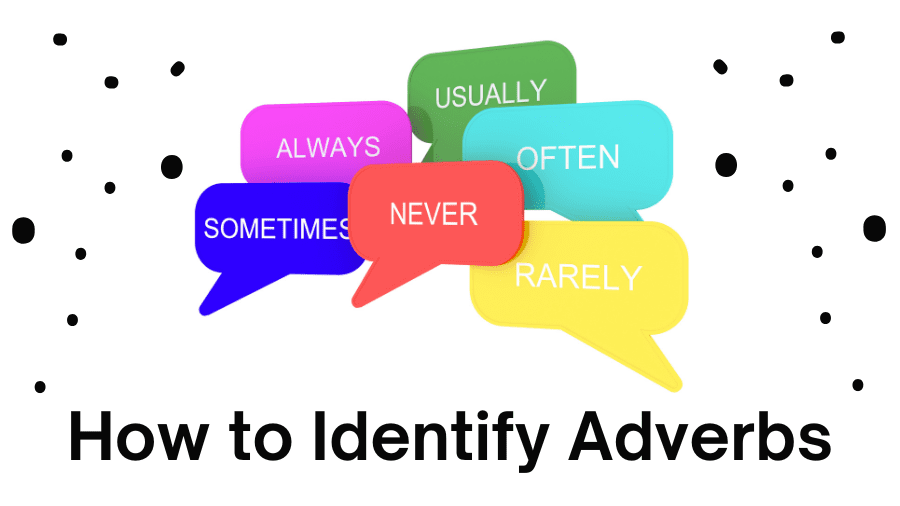
It can be tricky to identify adverbs, even if English is your first language. Confusion arises because some adverbs are irregular, and certain words can function as adverbs and adjectives. Furthermore, adverbs can appear at the beginning, middle, and end of sentences, making them challenging to pin down.
As a trained proofreader, I’ll introduce you to the main kinds of adverbs, show you how to identify them, and help you avoid confusing adverbs with adjectives—a common mistake. We’ll also learn why adverbs are important for communication.
Finally, I’ll offer you a quiz to see how adept you’ve become at spotting adverbs!
Key Takeaways for Identifying Adverbs
- Look for words that end in ly, but know many adverbs don’t have an ly ending.
- Find words that modify (i.e., describe) verbs, adjectives, adverbs, or entire sentences.
- Look for words that answer the following questions about the parts of speech they modify: how?, when?, where?, and to what extent? (how often? or how much?).
What Is an Adverb?
An adverb is one of the eight parts of speech in the English language.
Here are the parts of speech:
- nouns
- pronouns
- verbs
- adjectives
- adverbs
- prepositions
- conjunctions
- interjections
An adverb can modify (describe) three parts of speech: verbs, adjectives, and adverbs. Yep, you heard right—adverbs can modify other adverbs. 😊
How can we remember the three parts of speech adverbs modify?
I like to look at the word adverbs as a whole and in two parts.
I look at it as a whole to remember that adverbs can modify other adverbs.
Then I divide it into ad and verbs. The ad represents adjectives, and the verbs represents, well, you know. 😉
Here’s a picture to help you remember what parts of speech adverbs modify.
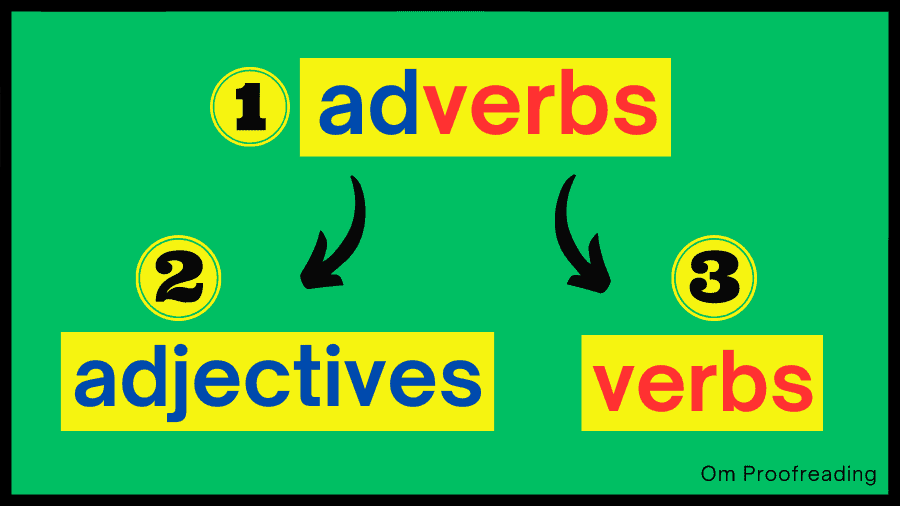
Adverbs can also modify entire sentences.
Believe it or not, they can even modify conjunctions and prepositions (source). However, these instances aren’t nearly as common and go beyond this article’s scope.
Soon, we’ll see examples of adverbs modifying verbs, adjectives, adverbs, and whole sentences.
For now, let’s discover the main kinds of adverbs so you can get a feel for the types of words we’ll be looking for when we learn how to identify adverbs in a sentence.
The Six Main Types of Adverbs
You can probably guess what each kind of adverb tells us just by looking at its name.
1) Adverbs of Time
Adverbs of time tell us when an action takes place.
Question they answer: when?
Examples:
- later
- immediately
- tomorrow
- tonight
- after
- before
- soon
- eventually
Example Sentence: They’re going to the hot springs tomorrow.
Explanation: The adverb tomorrow tells us when they’re going to the hot springs.
2) Adverbs of Place
Adverbs of place let us know where an action takes place.
Question they answer: where?
Examples:
- here
- there
- outside
- up
- nearby
- below
- somewhere
- upstairs
Example Sentence: Sarah studied abroad.
Explanation: The adverb abroad tells us where Sarah studied.
3) Adverbs of Degree
Adverbs of degree inform us about the intensity with which an action occurs.
Question they answer: to what extent? (how much?)
Examples:
- utterly
- fairly
- totally
- almost
- quite
- extremely
- particularly
- very
Example Sentence: The mountains are completely covered with snow.
Explanation: The adverb completely lets us know to what extent the mountains are covered with snow.
4) Adverbs of Frequency
Adverbs of frequency notify us of how often an action occurs.
Question they answer: how often?
Examples:
- usually
- seldom
- annually
- continuously
- occasionally
- periodically
- nightly
- sometimes
Example Sentence: Superman always protects the citizens of Metropolis.
Explanation: The adverb always tells us how often Superman protects the citizens of Metropolis.
5) Adverbs of Manner
Adverbs of manner convey how an action is performed.
Question they answer: how?
Examples:
- reluctantly
- gracefully
- seriously
- courageously
- vividly
- calmly
- carefully
- gently
Example Sentence: The little girl cheerfully picked a flower to give to her friend.
Explanation: The adverb cheerfully describes how the girl picked the flower.
6) Conjunctive Adverbs
Conjunctive adverbs join two independent clauses and show the relationship between them.
Examples:
- however
- therefore
- yet
- moreover
- rather
- consequently
- indeed
- likewise
Example Sentence: Laura was exhausted from a hard day’s work; nevertheless, she mustered up the energy to go to the party.
Explanation: The adverb nevertheless joins the two independent clauses and shows us their relationship.
Now we’re familiar with the primary kinds of adverbs—woot woot! 😊
How to Identify Adverbs in a Sentence (4 Tips)
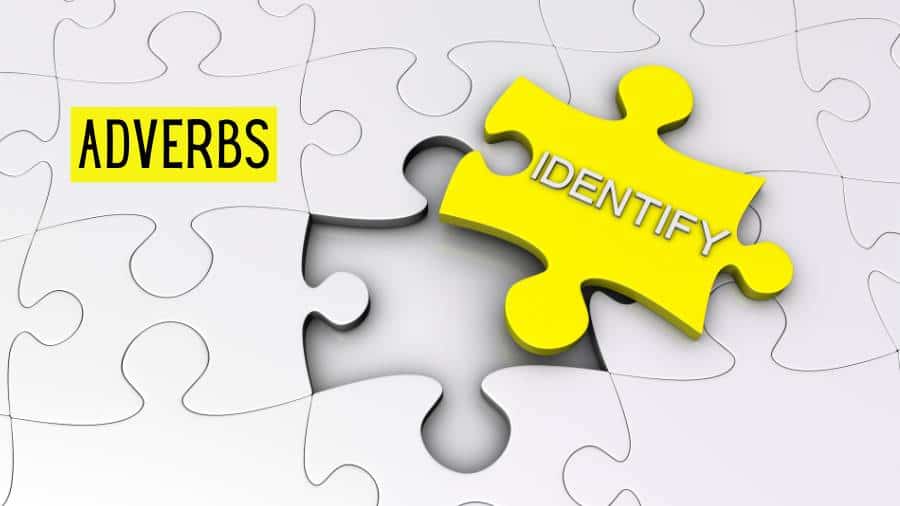
Let’s see how we can spot adverbs in a sentence without racking our brains.
I promise it’s not too perplexing if you follow these pointers.
1) Look for Words that End in ly (But Be Careful!)
In grade school, we were taught to identify adverbs by looking for words that end in ly. This tactic can work since lots of adverbs have an ly suffix.
In fact, adding ly to adjectives is a way to form adverbs.
For example, beautiful is an adjective, but beautifully is an adverb.
The ly ending is something to keep in mind since it can help us quickly identify adverbs in some cases.
However, it’s not foolproof. Why not?
Not all adverbs end in ly.
Here are some examples of words that don’t end in ly but can be used as adverbs:
- well
- here
- never
- earlier
- today
- very
- too
- almost
- often
- again
Now, let’s see a sentence with a word that ends in ly but functions as an adjective.
Example: The friendly child greeted his classmates.
In this sentence, friendly is an adjective that modifies the noun child.
Although friendly ends in ly, we rarely use it as an adverb.
The words lovely and curly—both adjectives—also end in ly.
And the word lily has an ly ending, but we almost always use it as a noun. 😉
As we examine example sentences throughout this article, we’ll encounter adverbs that end in ly and adverbs that don’t.
Let’s see other strategies for spotting adverbs.
2) Find Words that Modify Verbs, Adjectives, and Other Adverbs
Adverbs modify one of the following parts of speech:
- verbs
- adjectives
- adverbs
Soon, we’ll see examples illustrating how adverbs modify these parts of speech.
3) Find Words that Modify Entire Sentences
Adverbs that modify sentences are known as sentence adverbs. Shocker, right?
We’ll get into some examples of sentence adverbs too.
However, we need to pair the last two tips for identifying adverbs with the knowledge of what questions they answer when they modify a part of speech or a sentence.
4) Look for Words that Answer Specific Questions
When an adverb modifies a verb, adjective, or another adverb, it typically answers one of the following questions:
- How?
- When?
- Where?
- To what extent? (How often? or How much?)
I penned a post about the questions adverbs answer if you’d like to see example sentences specific to the questions listed above.
Now that we have the tools to identify adverbs, let’s see those examples!
Adverbs Modify Verbs
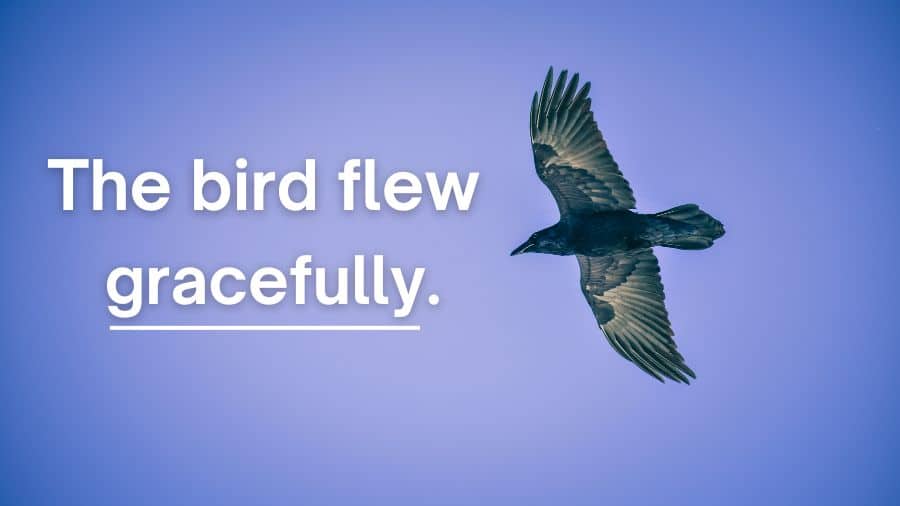
Adverbs can modify verbs.
Adverbs that modify verbs can come before or after the verb they modify.
They tell us something about the action being performed—typically how, when, where, or to what extent it happens.
1) Example: The bird flew gracefully.
The verb in this sentence is flew.
The adverb gracefully tells us how the bird flew.
- How did the bird fly? (gracefully)
2) Example: I’ll see my cousin tomorrow.
The verb in this sentence is see.
The adverb tomorrow tells us when I’ll see my cousin.
- When will I see my cousin? (tomorrow)
3) Example: Becky put her sweater there.
The verb in this sentence is put.
The adverb there lets us know where Becky put her sweater.
- Where did Becky put her sweater? (there)
4) Example: He frequently skates at the park.
The verb in this sentence is skates.
The adverb frequently tells us to what extent (how often) he skates.
- How often does he skate? (frequently)
I should clarify that we use adverbs with action verbs but not linking verbs.
Action verbs are words that show action:

- run
- jump
- sleep
- play
- swim
- dream
- dance
- stroll
- hum
- talk
All the verbs in the example sentences above (fly, see, put, skate) are action verbs.
We Use Adjectives (Not Adverbs) with Linking Verbs
Before we talk about using adjectives with linking verbs, let’s make sure we have a basic understanding of adjectives.
Here’s a helpful chart showing how adverbs and adjectives differ.
Adverbs vs. Adjectives
| Adverbs | Adjectives | |
|---|---|---|
| Parts of Speech They Modify | verbs, adjectives, & adverbs | nouns & pronouns |
| Questions They Answer | How? When? Where? To what extent? (How often? or How much?) | What kind? Which one? How many? |
| Used in Association With | action verbs | linking verbs |
Adjectives can only modify two parts of speech: nouns and pronouns.
Unlike adverbs that can modify other adverbs, adjectives cannot modify other adjectives.
Adjectives normally answer one of three questions concerning the nouns and pronouns they modify:
- What kind?
- Which one?
- How many?
As mentioned, we use adverbs with action verbs and adjectives with linking verbs.
So what are linking verbs?
Linking verbs link the subject of a sentence to a noun, pronoun, or adjective that describes the subject.
Linking verbs don’t show action; they show states of being.
We sometimes refer to linking verbs as state-of-being verbs.
Example Sentence: Pooja is kind.
Explanation: Pooja is the subject, is is the linking verb, and kind is an adjective that describes the subject.
You can think of a linking verb as an = sign. (Pooja = kind.)
Here are some examples of linking verbs:
- the “be” verbs (am, is, are, was, were, be, being, been)
- look
- sound
- smell
- taste
- feel
- seem
- become
- appear
Let’s look at some example sentences with linking verbs.
1) Incorrect: The girl seems happily.
This sentence is wrong because seems is a linking verb, and happily is an adverb.
Shout it from the rooftops: adjectives with linking verbs, adverbs with action verbs!
Correct: The girl seems happy.
That’s the ticket!
We used the adjective happy with the linking verb seems. The adjective happy describes the subject girl. (girl = happy)
On to the next one!
2) Incorrect: Peter feels badly about making his sister sad.
Yikes! This is a tough one. But we’ll figure it out together! 😊
In this sentence, feels is a linking verb.
How do we know?
We know because we’re talking about Peter’s state of being. We’re discussing how he feels in his heart, not how he feels something with his hands (an action).
Therefore, we need the adjective bad, not the adverb badly.
Correct: Peter feels bad about making his sister sad.
However, suppose we want to talk about the action of Peter feeling with his hands.
3) Incorrect: Peter feels bad because his hands became permanently numb after an accident.
Here, we’re talking about Peter’s action of using his hands to feel things. Since we use adverbs with action verbs, we need to use the word badly.
Correct: Peter feels badly with his hands because they became permanently numb after an accident.
That sentence isn’t the most graceful one I’ve ever written, but it illustrates the point.
If you’d like to see more examples of adverbs modifying verbs, I authored an article called “Can Adverbs Modify Verbs? (+ Examples and a Quiz).”
Adverbs Modify Adjectives

Adverbs can also modify adjectives.
Adverbs generally answer the question “to what extent?” or “how?” about the adjectives they modify.
We put adverbs that modify adjectives right before the adjective they modify.
1) Example: Julie was so thrilled to see her dogs.
The adjective in this sentence is thrilled.
The adverb so tells us how thrilled Julie was to see her dogs.
- How thrilled was Julie? (so thrilled)
2) Example: Pedro is quite glad he’ll sleep in his own bed tonight.
The adjective in this sentence is glad.
The adverb quite tells us how glad Pedro is about sleeping in his own bed tonight.
- How glad is Pedro? (quite glad)
3) Example: Those burritos are surprisingly scrumptious!
The adjective in this sentence is scrumptious.
The adverb surprisingly tells us how scrumptious those burritos are.
- How scrumptious are those burritos? (surprisingly scrumptious)
If you’d like more info about how adverbs modify adjectives, Om Proofreading has an article called “Can Adverbs Modify Adjectives? (+ Examples and a Quiz).”
Now let’s watch adverbs show off as they modify other adverbs. 😉
Adverbs Modify Other Adverbs
Adverbs can even modify other adverbs.
Adverbs typically answer the question “how?” or “to what extent” about the adverbs they modify.
Adverbs that modify adverbs should come right before the word modified.
1) Example: Tom drove exceedingly fast despite the speed limit.
The adverb fast modifies the verb drove. It tells us how Tom drove.
The adverb exceedingly modifies the adverb fast. It tells us how fast Tom drove.
- How fast did Tom drive? (exceedingly fast)
2) Example: The baby slept surprisingly soundly.
The adverb soundly modifies the verb slept. It tells us how the baby slept.
The adverb surprisingly modifies the adverb soundly. It tells us how soundly the baby slept.
- How soundly did the baby sleep? (surprisingly soundly)
3) Example: Sabir hit the ball incredibly hard.
The adverb hard modifies the verb hit. It tells us how Sabir hit the ball.
The adverb incredibly modifies the adverb hard. It tells us how hard Sabir hit the ball.
- How hard did Sabir hit the ball? (incredibly hard)
If you’d like to delve deeper into how adverbs modify adverbs, I published a post called “Can Adverbs Modify Adverbs? (+ Examples and a Quiz).”
Last but not least, let’s look at adverbs modifying entire sentences.
Adverbs Modify Sentences

Finally, adverbs can modify whole sentences. Holy moly!
“Sentence adverbs most commonly indicate doubt or emphasize a statement’s certainty. Some common examples are maybe, possibly, and however.”
Source: The Chicago Manual of Style
Sentence adverbs don’t merit much explanation—they simply modify the entire thought expressed.
Sentence adverbs usually come at the beginning of the sentences they modify. But they can also come at the end or in the middle of sentences.
To keep it simple, let’s look at a few sentence adverbs in their favorite spot: the beginning.
1) Example: Indeed, the crashing waves were breathtaking!
2) Example: Maybe it’s what she had hoped for.
3) Example: However, they enjoyed each other’s company immensely.
4) Example: Fortunately, it will be warmer tomorrow.
Welp, I think adverbs are pretty impressive. Why?
- They often come in first place, like in the sentences above. 😉
- They’re versatile since they can modify a few parts of speech and even entire sentences.
- They can modify other adverbs without having an identity crisis.
As we wrap up our discussion about how to recognize adverbs, let’s look at a common pitfall that can lead to cases of mistaken identity.
Avoid Mistaking Adjectives for Adverbs
Sometimes we may think a word is an adverb when it’s an adjective, or vice versa.
Let’s see how to avoid being fooled.
How to Tell the Difference between Adjectives and Adverbs
Here are three tips to ensure you correctly identify a word as an adverb or adjective.
You can use the table (Adverbs vs. Adjectives) we saw earlier to refresh your memory about these pointers.
1) Know the parts of speech they modify.
Luckily, adverbs and adjectives modify different parts of speech.
When you have trouble determining whether a word is an adjective or an adverb, first figure out what part of speech it modifies (describes).
2) Memorize the questions they answer.
Adverbs and adjectives answer different questions.
If you get confused, ask yourself what question a particular word answers when it modifies another word.
3) Remember that we use adverbs with action verbs and adjectives with linking verbs.
When in doubt, this strategy can help you out.
Some Adverbs Are Irregular
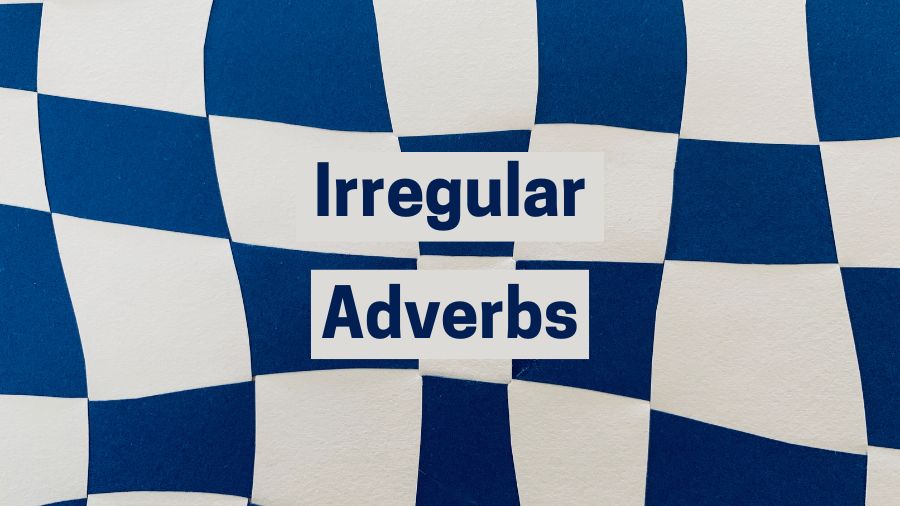
We usually tack ly onto the end of an adjective to form an adverb, but not always.
Here are examples of irregular adverbs.
Irregular Adverbs
| Adjective | Adverb |
|---|---|
| good | well* |
| hard | hard** |
| late | late*** |
| fast | fast |
| far | far |
| straight | straight |
| early | early |
| daily | daily |
Good vs. Well
* Well is the adverb equivalent of the adjective good.
Correct: Damian slept well last night.
The adverb well modifies the verb slept. It tells us how Damian slept.
Incorrect: Damian slept good last night.
This example is incorrect because we don’t use adjectives to modify verbs.
Correct: She read a good book.
The adjective good modifies the noun book. It tells us what kind of book she read.
Incorrect: She read a well book.
This example is incorrect because we don’t use an adverb to modify a noun.
Hard and Hardly
** Hard is an adverb, and so is hardly. But they have different meanings.
Example: The boy hit the ball hard. (hard = with force)
Example: He could hardly eat. (hardly = barely)
Late and Lately
*** Late is an adverb, and so is lately. But they have different meanings.
Example: Baxter arrived late. (late = tardy)
Example: Lately, she’s been able to sleep through the night. (lately = recently)
Is It an Adverb or an Adjective?
Now let’s look at example sentences with two other words from the table above: fast and daily.
Fast can serve as an adjective or an adverb. The same is true for daily.
Fast Used as an Adjective and an Adverb
Adjective: He drives a fast car. (fast modifies the noun car)
- What kind of car does he drive?
Adverb: He drives fast. (fast modifies the verb drive)
- How does he drive?
Daily Used as an Adjective and an Adverb

Adjective: She likes to read the daily paper. (daily modifies the noun paper)
- Which one (which paper) does she like to read?
Adverb: She reads the paper daily. (daily modifies the verb reads)
- To what extent (how often) does she read?
Why Are Adverbs Important?
Let’s explore four reasons why adverbs are essential in speech and writing.
1) They help us communicate clearly.
Example: She answered the question reluctantly.
What if we said she answered the question willingly?
The information provided by the adverb helps to communicate how she feels about answering.
2) Adverbs can convey a specific tone.
Example: He eagerly waited for his friend to arrive.
What if he angrily waited for his friend to come? That would set a much different tone.
3) They add emphasis.
Example: She was extremely pleased with her accomplishment.
The adverb extremely emphasizes how pleased she was with what she achieved.
4) Adverbs spice up our writing.
Which of the following sentences do you prefer to read?
Example: He eagerly waited for his friend to arrive.
Example: He waited for his friend to arrive.
If you chose the first sentence, I’m with you.
In addition to allowing us to communicate thoughts more clearly and emphatically, adverbs add zest to what we express.
However, I should point out that overusing adverbs is considered a no-no.
Avoid Overusing Adverbs
Adverbs are important, but using them too often takes the pizzazz out of our writing.
If we employ a bit of brain power, we can usually think of a more descriptive verb or adjective and avoid the need to use an adverb.
For example, let’s look at a sentence we saw earlier:
- Good: She was extremely pleased with her accomplishment.
We could punch up our prose by saying one of these sentences instead:
- Better: She was delighted with her accomplishment.
- Better: She was overjoyed with her accomplishment.
You can use a thesaurus to help you come up with powerful synonyms for words that need a boost.
Before we get into the quiz, let’s answer some common questions.
Frequently Asked Questions
What is the easiest way to find adverbs?
The easiest way to find adverbs is to understand the parts of speech they modify (describe): verbs, adjectives, and other adverbs. Also know that adverbs answer the following questions about the words they modify: how?, when?, where?, and to what extent? (how often? or how much?).
Do all adverbs end in ly?
Not all adverbs end in ly. Here are some adverbs sans the ly ending: so, yesterday, often, never, there, however, quite, so, likewise, almost, therefore, before, nearby, sometimes, and outside.
How do you identify an adverb without ly?
To identify an adverb that doesn’t end in ly, you need to remember the parts of speech adverbs modify: verbs, adjectives, and adverbs. Then, keep in mind the questions they answer when modifying one of those parts of speech: how?, when?, where?, and to what extent? (how often? or how much?).
You may also find it useful to look at this list of adverbs, which contains many adverbs without an ly ending.
Quiz: Identify the Adverbs
Now that you know more about adverbs and the words they modify, here’s your opportunity to identify adverbs on your own.
You’ll receive feedback for any questions you miss.
You can do it! 😊
Important: After completing the quiz, you’ll need to scroll back up the page and click the “View score” button.
I hope this article has given you helpful tips for identifying adverbs. Keep practicing, and you’ll be an adverb ace before you know it!
Best wishes to you!
“Be the change that you wish to see in the world.”
– Mahatma Gandhi
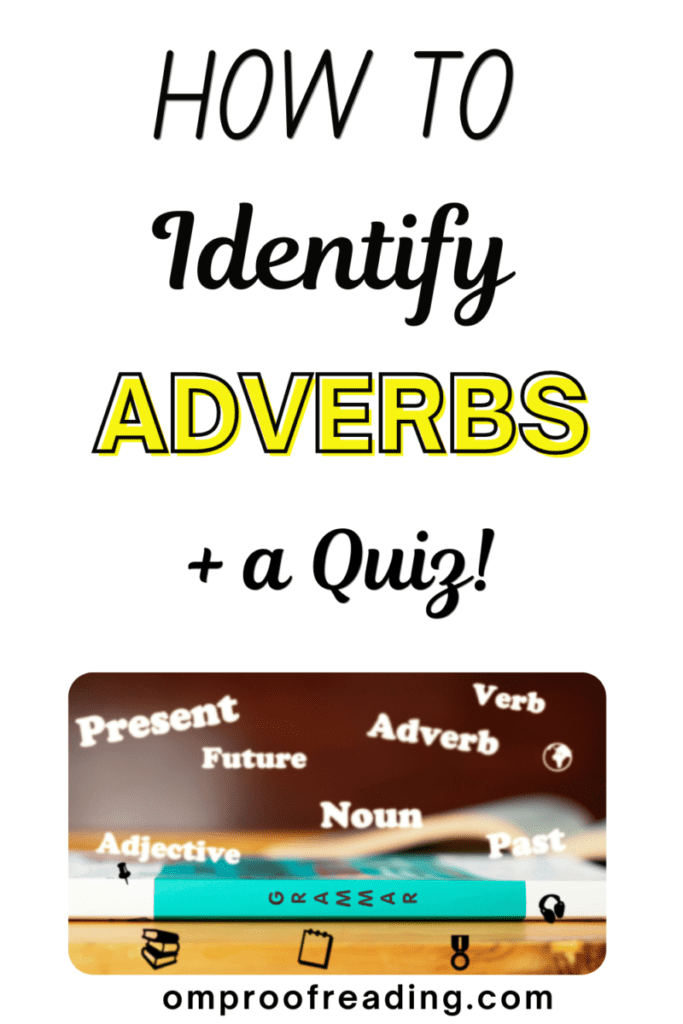
Recent Posts
Punctuation is important because it enables us to communicate our message clearly and effectively. Without punctuation, we wouldn’t understand how units of a sentence relate to one another or how...
Although you're probably somewhat familiar with adverbs, you may be unaware of sentence adverbs. As a trained proofreader who has studied the parts of speech, I can help you understand this unique...
